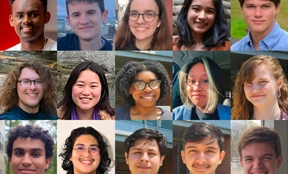
TREND 2024 end-of-summer conference poster gallery and booklet.

Project type: Computation and Experiments
A time-delayed nonlinear dynamical system is characterized by the fact that the present state is influenced by past states. This apparently benign feature is actually the root of much complexity in real-world nonlinear systems, as it typically transforms a low-dimensional system into a high-dimensional one. Indeed, the dynamical properties of time-delayed oscillators critically depend on the time scales involved, mainly defined by the delay itself and the various filtering processes involved in the nonlinear oscillations. The aim of this project is to explore some of these dynamical regimes with networks of time-delayed optoelectronic oscillators (or OEOs). The versatility in timescales offered by this system has paved the way for several applications such as chaos communications, microwave generation, neuromorphic computing, sensing, and wideband radar/lidar detection where networks of oscillators are often involved.
Synchronization, the dramatic phenomenon in which interconnected dynamical systems evolve in unison, is observed in a variety of man-made and natural systems, including power distribution, telecommunications, and biological networks. The question of whether and how networks synchronize, and the relationship between network topology and synchronization, are of fundamental importance in each of these examples and applications of coupled nonlinear oscillators mentioned above.
Students working on these projects theoretically and experimentally investigate nonlinear time-delayed oscillators and synchronization phenomena in optoelectronic networks and address important open questions, such as:
The research questions are accessible to students from a wide variety of disciplines and backgrounds and introduces students to lasers, fiber optic instrumentation, programmable electronics, instrument automation, and numerical simulation. This research provides a rare opportunity to apply these newly acquired skills to answer scientific questions in a new and rapidly developing field: the spatio-temporal dynamics of networks.
Prof. Yanne Chembo has an extensive publication record related to the fundamental theory and applications of OEOs. Five of his latest students defended a PhD on this topic. He joins Professors Murphy and Roy for the TREND 2019 program. They have mentored many undergraduates through the TREND program, resulting in several papers, including Physical Review and Letters publications on synchrony and bidirectional communication with delay-coupled nonlinear oscillators. Two recent PhD graduates from the Roy/Murphy lab are former TREND alumni.
Want help getting in touch with these mentors? Reach out to Daniel.